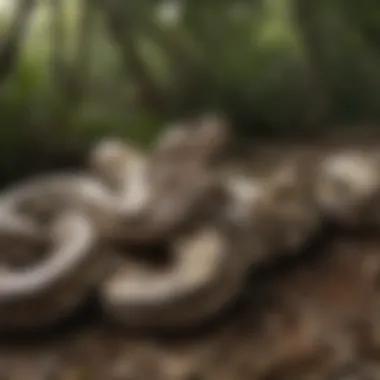Burmese Pythons in the Everglades: Ecology and Impact


Nature Topic Overview
Burmese pythons, native to Southeast Asia, have become a major topic of concern in the Everglades. These snakes, which can grow longer than a school bus, were brought to Florida as pets. However, when owners could no longer care for them, they released them into the wild. What was once a curious choice has turned into an ecological crisis.
The Everglades, a unique swampy ecosystem teeming with life, faces challenges from these powerful predators. It’s important to understand how they fit—or rather don't fit—into this environment. Here, we will explore their biology, habitat preferences, and the intricate web of life within the Everglades that has been disrupted by the presence of these snakes.
Fun Facts and Trivia
- Size Matters: The Burmese python is one of the largest snakes in the world! The record length of one captured in Florida was nearly 20 feet.
- Camouflage Champs: Their scales have a striking pattern, allowing them to blend into the lush vegetation of their environment.
- Mommy's Love: Contrary to many reptiles, a mother Burmese python will protect her eggs until they hatch, which makes them quite unique among snakes.
Engaging activities like drawing or coloring sheets of these stunning creatures can bring educational value. Imagine creating a Burmese python coloring page and sharing it with friends!
Wildlife Explorations
In the Everglades, the presence of Burmese pythons means trouble for various native species. Let's dive deeper into the inhabitants of this habitat.
Native Species at Risk
- American Alligator: Once at the top of the food chain, these ancient reptiles now face competition and predation from pythons.
- Wood Stork: These birds, usually seen soaring above the waters, are losing their young to the hungry snakes.
- Rabbits: Unfortunately, many rabbits have become a meal for Burmese pythons, impacting their population.
Knowing about these species and their struggles can inspire thoughts about animal conservation.
Environmental Awareness
With the introduction of Burmese pythons in the Everglades, many ecosystems are facing tough challenges. This highlights the importance of protecting our nature and preserving the delicate balance of our ecosystems. Here are some suggestions:
- Spread Knowledge: Talking about what you learn with friends and family can raise awareness.
- Support Local Conservation Groups: Organizations working to manage the python population can use your support.
- Respect Wildlife: If you see an animal in the wild, observe from a distance; always remember not to disturb their home.
DIY Nature Activities
To truly understand the impact of Burmese pythons in the Everglades, why not try some hands-on activities? Here are a few fun projects:
Create a Habitat Model
- Gather materials like cardboard, paint, and plastic animals to build a miniature Everglades ecosystem.
- Include various animals, and even add a snake to explore how different species interact.
Nature Scavenger Hunt
- Create a list of items to find related to the Everglades habitat.
- Look for things like leaves, rocks, or even bird feathers on your next outdoor adventure.
These activities not only teach about Burmese pythons but also about how we can work together to protect our fragile ecosystems.
Remember: Protecting nature is not just one person's job; it's everyone’s responsibility.
Foreword to Burmese Pythons
Burmese pythons have made quite a splash in the Everglades, gaining notoriety for their role as an invasive species. Understanding their journey to this unique ecosystem is crucial, not just for wildlife enthusiasts but also for anyone interested in conservation efforts. These large snakes pose significant challenges to native flora and fauna, making them a pressing focus for environmental scientists and educators alike. Delving into the world of Burmese pythons helps illuminate the intricate balance of nature, showcasing how one species can tip the scales in an ecosystem.
Origin and Natural Habitat
The name "Burmese python" nicely signifies their roots. Native to Southeast Asia, these snakes thrive in tropical forests and grasslands, where they enjoy a warm climate and plentiful food. They are ambush predators, using their camouflage to stalk unsuspecting prey. Understanding their origin is like peeling back the layers of an onion; it opens up a view into their adaptations and behaviors that are now being tested in a completely foreign environment—the Everglades.
Burmese pythons prefer habitats with abundant covers, like thick vegetation near water sources. They are an adaptable species, often found near swamps, marshes, and rivers. This versatility aids in their survival in the diverse ecosystems of Asia. Yet, should they find themselves in more temperate or cooler environments, their survival tactics would likely suffer.
Prelude to the Everglades
The Everglades is not your average swamp—it's a sprawling network of wetlands that plays a critical role in Florida's ecology. This UNESCO World Heritage Site is home to a multitude of species, both majestic and modest, some of which may be threatened or endangered. A unique feature of the Everglades is its slow-moving waters, which shape the landscape and create habitats for a diverse array of events—namely the habitats needed by native animals and plants.


However, not all that moves through the Everglades is benign. The introduction of Burmese pythons alters this delicate ecosystem. These snakes are now a common sight blanketing the vast stretches of the wetlands. This introduction raises concerns, as they pose a significant threat to native wildlife. Without natural predators, the pythons flourish—much to the detriment of the local fauna.
"Ecosystems are like a tapestry—remove one thread, and the whole design can unravel."
A study by the National Park Service highlights that these pythons have become significant contributors to the decline of several mammal and bird populations in the Everglades. They not just fill importantly ecological niches but also illustrate how human activity, be it intentional or inadvertent, can have long-lasting effects on ecosystems. By grasping the parallels between their origin and the tasks they perform in their newfound habitat, we gain insight into the intricate web of life at play in the Everglades.
Biological Characteristics
Understanding the biological characteristics of Burmese pythons is fundamental to comprehending their role in the Everglades ecosystem. These traits not only inform us about their adaptability and survival skills but also provide insight into the challenges they present as an invasive species. By delving into their physical attributes and reproductive behavior, we can better grasp the implications of their presence in this delicate environment.
Physical Attributes
Size and Weight
One of the most striking aspects of Burmese pythons is their size. These snakes can grow to an impressive length, often exceeding 18 feet. Weighing anywhere from 100 to 200 pounds, they dominate their surroundings, making them formidable predators. Their sheer size plays a critical role in their predatory prowess, allowing them to consume a variety of prey ranging from birds to mammals.
A noteworthy characteristic of their size is that it enables them to compete effectively against local wildlife. In the context of the Everglades, this poses a significant threat to native species. Larger Burmese pythons are particularly efficient predators, leading to the decline of small mammals and other susceptible animals in the region. This trait effectively makes them the apex predator in their adopted habitat.
However, this colossal size also has disadvantages. It requires a substantial amount of food to sustain themselves, which can lead to competition for scarce resources among other wildlife. As they drain the local population of prey, the balance of the ecosystem may tip unfavorably.
Coloration and Patterns
The coloration and patterns of the Burmese python are not just for show; they serve several important functions, the most significant being camouflage. Their skin is often a mix of browns, yellows, and greens, which helps them blend seamlessly with the marshy surroundings of the Everglades. This key characteristic allows them to remain hidden from both predators and prey alike.
Moreover, their unique patterning, marked by darker blotches on a lighter background, is an evolutionary adaptation that enhances their hunting success. Residing in a vibrant ecosystem, their ability to go unseen while waiting for prey increases their effectiveness as hunters.
On the downside, these beautiful patterns can also have disadvantages. While their appearance enables stealth, it might also attract attention from humans and poachers interested in their skins. This duality underscores the complexity of their existence in the Everglades, where every attribute serves both a purpose and a potential risk.
Reproductive Behavior
Understanding the reproductive behavior of Burmese pythons sheds light on how their populations can rapidly expand in the Everglades. These aspects are vital to monitoring and managing their impact.
Mating Patterns
Burmese pythons have distinct mating patterns that contribute to their success as an invasive species. They typically breed in the late winter or early spring, when temperatures are ideal. During this time, males seek out females through a series of vocalizations and pheromone signals, a fascinating process that allows them to find mates amidst the dense vegetation of the Everglades.
A notable characteristic of their mating behavior is that females can mate with multiple males during a single breeding season. This reproductive strategy increases genetic diversity among the offspring, which can enhance their adaptability to various environmental conditions. Such resilience is crucial for survival, particularly given the pressures of an invasive environment.
The downside is that this breeding efficiency can lead to exponential population growth, compounding the challenges faced in controlling Burmese python numbers within the ecosystem.
Egg-Laying and Incubation
When it comes to reproduction, the egg-laying and incubation behaviors of Burmese pythons are equally intriguing. Female pythons can lay as many as 30 to 100 eggs at a time, choosing secluded spots such as abandoned burrows for protection. This ability to conceal their nests is a significant advantage in safeguarding their offspring from predators.
The unique feature of their incubation process is that mothers will sometimes coil around their eggs to maintain a steady temperature. This caring behavior highlights a remarkable aspect of their biology. However, this parental investment also consumes energy and resources, which could be expended on other survival needs.
The challenge emerges when numerous egg clutches hatch nearly simultaneously. This rapid increase in hatchlings can further strain the local ecosystems and intensify the competition for resources, exacerbating the impact on native wildlife.
Overall, studying the biological characteristics of Burmese pythons is crucial to understanding their ecological influence in the Everglades. Each trait they possess—whether size, coloration, mating behaviors, or reproductive strategies—intertwines with their role as invaders in this fragile habitat, making it imperative for conservationists and the public to engage with the challenges these snakes present.
Ecological Role of Burmese Pythons
The presence of Burmese pythons in the Everglades is not just another tale of an invasive species; it's a significant chapter in the ongoing story of our ecosystem's health. Understanding their ecological role allows us to appreciate both the complexity and the fragility of the Everglades environment. Pythons function as apex predators in this ecosystem, wielding influence over numerous species and the overall ecological balance.
Predator and Prey Relationships
Burmese pythons play a pivotal role in shaping the dynamics of predator-prey relationships within the Everglades. As formidable hunters, these snakes utilize their size and strength to control populations of various animals, ensuring that no single species dominates the landscape.
Their diet is diverse, ranging from small mammals to reptiles and birds. This adaptability allows them to thrive in a multitude of conditions, but it also leads to a significant impact on the native wildlife population. When these snakes feast on raccoons or opossums, for instance, it might seem harmless at first. However, the ripple effects of diminishing these small mammals can lead to overpopulation of other species and a breakdown in the delicate ecological balance.


Impact on Native Wildlife
The effects of the Burmese pythons on native wildlife are profound and far-reaching. Understanding this impact helps underscore the seriousness of their presence. Reports from wildlife experts show alarming trends in the decline of various species, particularly small mammals and birds.
Decline of Small Mammals
A notable effect of the python's invasion is the significant decline in populations of small mammals. Where once these creatures flourished, their numbers have dwindled almost beyond recognition. Species such as the Eastern cottontail rabbit and various rodents have experienced drastic reductions in their populations.
This decline is a key focus because small mammals play a fundamental role in the ecosystem, serving as prey for multiple predator species. The absence of such animals can lead to a cascade of ecological consequences, including the potential rise of insects, which in turn could disrupt vegetation.
The unique feature of this decline is its visibility. Observing fewer rabbits and other small mammals will likely bait the curiosity of researchers, educators, and nature enthusiasts alike. This presents a pressing issue that is more than just numbers—it’s about the health of an entire ecosystem, showcasing the need for conservation efforts.
Effects on Bird Populations
Birds, too, face severe challenges due to the presence of Burmese pythons. Many avian species, including herons and migratory birds, find themselves vulnerable to python predation. Their eggs and chicks, often left unattended in nests, become easy targets for these snakes.
Bird populations are not just affected in terms of numbers but also in their ecology. The decline in bird species can significantly affect pollination and seed dispersal, essential services that contribute to healthy plant life. As these avian species disappear, we risk losing the intricate relationships between flora and fauna that have existed for thousands of years. The unique aspect of this threat lies in how interconnected all life forms are—a decline in one species can trigger a chain reaction of decline in another.
Invasion of the Everglades
The encroachment of Burmese pythons into the Everglades is not just a tale of one species taking over another; it’s a complex narrative that reveals the tangled relationship between humans and nature. Understanding this invasion is crucial for grasping the overarching ecological challenges we face today. Burmese pythons, once cherished as exotic pets, now roam freely in one of the most delicate ecosystems in North America, affecting countless native species. Recognizing the causes behind their introduction and how they spread helps illuminate the larger themes of biodiversity, ecosystem balance, and human responsibility.
Causes of Foreword
Pet Trade
A significant factor linking Burmese pythons to the Everglades is the pet trade, which has become an essential part of their story. These snakes gained popularity during the late 20th century, with many households in the United States adopting them as unique pets. Their striking patterns and relatively manageable size (when they’re young, at least) made them appealing in the eyes of pet enthusiasts. But the key characteristic of the pet trade is its often short-sighted nature; as these snakes grow, many owners found themselves unable to care for them anymore.
When people decide to release their pet pythons into the wild, it isn’t just a simple act of letting nature take its course. Instead, it contributes to the larger problem of invasive species, making it a disadvantage for the very ecosystem they were trying to enjoy. As a result, these released snakes thrive in their new environment, rapidly adapting and, in some cases, even mating with local populations.
The Role of Climate
The climate in Florida also plays a pivotal role in the success of Burmese pythons in the Everglades. The warm subtropical climate provides an ideal habitat for these reptiles, allowing them to thrive without the challenges they might face in less hospitable environments. This adaptability is a key characteristic, allowing them access to food and shelter that supports their population growth.
One unique feature of the climate’s impact is the extended breeding season that allows Burmese pythons to reproduce in large numbers. Every year, hundreds of eggs can be laid, increasing the chances of survival for the next generation. However, this can lead to an overwhelming proliferation of pythons, creating major ecological repercussions—particularly as they begin to dominate the areas they inhabit.
Spread and Population Growth
Once the Burmese pythons were established in the Everglades, their spread escalated rapidly. Factors such as high adaptability, lack of natural predators, and ample food sources led to an explosion in their population numbers. The rapid growth is alarming, bringing about noticeable changes in the local ecosystem. Here’s how:
- Increased predation: Pythons don’t discriminate when it comes to their dinner. They consume a wide variety of prey, including birds, mammals, and even alligators. This predation pressure has significant effects on the native wildlife.
- Ecosystem imbalance: As they continue to thrive, Burmese pythons disrupt the delicate balance of nature, leading to declines in local species diversity and altering food webs.
- Management issues: The burgeoning population complicates control efforts. Finding effective methods to manage these snakes becomes increasingly difficult, showcasing the need for proactive strategies.
"The invasion of Burmese pythons represents a wake-up call about the importance of invasive species management and the responsibility we bear for the ecosystems we interact with."
In summary, understanding the invasion of Burmese pythons in the Everglades requires a multifaceted approach that considers the roles of human behavior and environmental factors. Addressing this issue is not merely an ecological concern; it's a call for greater awareness and action to protect vulnerable ecosystems.
Management Challenges
The challenges related to managing Burmese pythons in the Everglades are numerous and complex. This section highlights the hurdles that conservationists and authorities face, emphasizing how these challenges affect both local ecosystems and the effectiveness of control strategies. Understanding these management challenges is crucial for anyone interested in effective wildlife management practices.
Highlights of Current Management Strategies
Currently, a multifaceted approach is being utilized to tackle the Burmese python problem in the Everglades. These strategies include:
- Public Hunting Events: The state organizes events where citizens can participate in hunting pythons. This encourages public engagement while attempting to reduce population numbers.
- Monitoring and Tracking: Scientists and wildlife officials are using radio collars and GPS tracking to better understand python movements and behaviors.
- Trapping Programs: Specialized traps have been developed to capture these snakes effectively without harming other wildlife.
- Research Initiatives: Ongoing studies are critical in understanding the ecological impact of pythons and exploring new methods for control.
These strategies show promise, but they require continuous evaluation to adapt to the evolving situation.
Challenges Faced in Control Efforts


Despite the best efforts, controlling Burmese pythons remains a daunting task. Two primary issues complicate these efforts: public awareness and resource limitations.
Public Awareness Issues
Public awareness plays a pivotal role in the success of management strategies. Many people may not realize the invasive nature of Burmese pythons or their impact on the native ecosystem. The key characteristic of this issue is lack of engagement. Without sufficient understanding, the local community may hesitate—or outright resist—efforts aimed at reducing python populations.
- Educational Outreach: Programs designed to teach about the environmental consequences of invasive species have shown some success, yet reaching broader audiences remains tricky. Educating children and parents is especially vital, as this shapes future generations' understanding of ecological balance.
- Social Media Campaigns: While social media can disseminate information quickly, misunderstanding can also spread as fast. Misinformation regarding the pythons could hinder management efforts.
The uniqueness of these public awareness issues lies in how they directly affect participation in control efforts. Increased public understanding not only aids in reducing the python population but also fosters community responsibility.
Resource Limitations
Resource limitations present a substantial obstacle for managing invasive species like Burmese pythons. This refers not only to funding but also to manpower and technological resources.
- Financial Constraints: Government budgets often prioritize other pressing issues. This lowers the funding available for python management programs, leading to suboptimal control measures.
- Staffing Shortages: The number of trained professionals to actively manage these snakes is woefully insufficient for the scale of the problem. This means that effective monitoring and rapid response to python sightings can often fall through the cracks.
The unique feature of resource limitations is that they affect all aspects of management, from immediate responses to long-term research initiatives. Without adequate resources, strategies already in place may fail to make a tangible impact.
"To effectively tackle the Burmese python invasion, a collaborative approach combining education, community involvement, and adequate funding is necessary."
Conservation and Future Directions
Conservation of Burmese pythons in the Everglades is a pressing matter that extends beyond simple wildlife management. It’s about acknowledging the delicate balance of ecosystems, where every species plays a role. In the Everglades, Burmese pythons demonstrate a duality—acting both as a fascinating creature and a formidable invasive species. Their management requires attention to various factors that promote not only the species’ control but also the preservation of the native biodiversity.
Research and Monitoring Initiatives
Research is a cornerstone of effective conservation strategies. Understanding the biology and ecological dynamics of Burmese pythons is essential. Researchers utilize methods like radio telemetry, which involves tracking the movements of pythons with radio transmitters. This data helps in understanding their predation patterns and habitat preferences.
- Monitoring Population Dynamics: Examining how their numbers change over time gives insights into their impact on native wildlife. This is significant in assessing their role as an apex predator in the Everglades.
- Behavioral Studies: Knowing how pythons hunt and breed can inform management strategies. For instance, data indicates that they typically prefer wetland areas, which can guide control efforts.
The collaboration between universities, wildlife agencies, and local communities enhances these monitoring efforts. As more data is collected, it can inform effective interventions that consider both the pythons and the surrounding ecosystem.
Community Involvement and Education
Communities play a pivotal role in conservation. The more locals are engaged and educated about the challenges presented by invasive species, the better the outcomes for the environment. Community workshops, school programs, and outreach initiatives can raise awareness about the impact of Burmese pythons.
Some key elements of community involvement include:
- Educational Campaigns: Engaging local schools and organizations to inform them about the ecological significance of native species and the dangers of invasive ones. Simple lessons can teach children why pythons might not belong in the Everglades.
- Participatory Control Efforts: Local initiatives, like python removal contests, encourage residents to actively participate in reducing python populations. These events can foster a sense of ownership concerning the health of their environment.
"Conservation starts with us. By being informed and involved, communities can help protect their natural treasures and ensure a balanced ecosystem."
The road ahead for conservation of Burmese pythons involves not just scientific interventions, but also the hearts and minds of the communities around the Everglades. By fostering a connection between people and nature, we can maintain the fragile beauty of this ecosystem and safeguard it against the challenges posed by invasive species.
The End
The conclusion is a vital part of this article, bringing together all the threads of Burmese pythons' presence in the Everglades. Here, we underscore several key aspects, and why understanding these implications matters. This segment not only serves as a summary but also as a reflection on the broader picture surrounding these fascinating yet problematic serpents.
Summary of Findings
Throughout the article, we’ve seen how Burmese pythons were introduced to the Everglades environment. These reptiles can grow quite large and possess hunting skills that have drastically shifted the balance of local ecosystems. Here’s what we've found:
- Ecological Imbalance: The introduction of the pythons has led to a significant decline in small mammal populations, which has cascading effects for various species that depend on these mammals for food.
- Competition for Resources: Burmese pythons are formidable predators. Their rise has put stress on native predators, as they compete for the same food sources. This means that local wildlife struggles to survive.
- Human Impact: Human activities, such as the pet trade and habitat changes due to development, have fueled this invasion, leading to problems we face today.
In summary, the introduction of Burmese pythons has multifaceted effects—resulting in changes to the species composition in the Everglades, affecting both predator and prey alike.
Call for Continued Awareness and Action
With the details uncovered in this article, it is crucial for all of us to keep our eyes wide open. Awareness is the first step towards action. Understanding the plight of the Everglades and the impact of Burmese pythons can foster advocacy and engagement. Each one of us can play a role:
- Education Programs: Schools and community centers should include information on local ecosystems and the species that inhabit them. This can help young minds realize the importance of maintaining ecological balance.
- Participate in Conservation Efforts: Get involved with organizations focused on saving the Everglades. They often have volunteer programs that allow individuals to participate in restoration work or python monitoring.
- Public Outreach: Share what you learn. Discuss the need to respect wildlife and understand the consequences of releasing non-native species into the environment.
"Nature is not a place to visit. It is home." – Gary Snyder
By raising awareness and taking action, we advance the chances of preserving the delicate ecosystem of the Everglades for future generations. The urgency is real, and our responsibility as stewards of the environment cannot be overstated. In every small measure, we can contribute toward restoring the balance and protecting the intricate weave of life in this treasure of nature.







